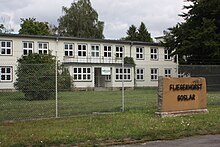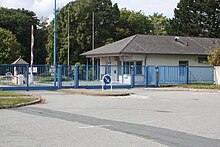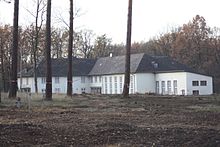Goslar Air Base
|
|
|||
|---|---|---|---|
| country | Germany | ||
| today | z. T. unused, z. T. used civilly | ||
| local community | Goslar | ||
| Coordinates : | 51 ° 56 ' N , 10 ° 26' E | ||
| Opened | 1926 | ||
| Old barracks names | |||
| 1926-1936 | Goslar Airport |
|
|
| Formerly stationed units | |||
| Paratrooper Regiment 3 of the 1st Paratrooper Division Airborne Squadron 1, Transport Squadron 3 Weather Reconnaissance Squadron (Westa) 26 reconnaissance groups F 27, F 122 Italian transport groups "Terraciano" and "Trabuchi" Detachement Electronique 33, later Escadron Electronique Sol 33/351 Telecommunications Regiment 33 Air Force Training Regiment 33 Air Force Training Regiment 3), later also LAR 5 or 1 |
|
||
|
Location of the Goslar Air Base in Lower Saxony |
|||
The area of the civil airport and later Goslar air base is located on the northern outskirts of the Lower Saxony city of Goslar .
history
Civil use (1925–1937)
In 1925 the first steps to search for a suitable site for a new airfield to be built in the vicinity of the city of Goslar began . The facility should connect the place to the growing civil German air traffic network. In October 1926 there were first flight movements on the area. The official opening of the "Goslar Airport" took place on June 19, 1927. The volume of air traffic rose to over 200 landings in the first half of 1931. The airport served as a small regional airport and as an emergency landing site for international routes such as Berlin-Cologne-Paris. In 1932 the first hangar was put into operation.
Military use (1937-1945)
The establishment of the air force , initially camouflaged because of the provisions of the Versailles Treaty, began in January 1933. The outwardly civilian-looking front organization "Deutsche Luftverkehrs- und Handels-AG Berlin" (DELHAG) concluded a contract with the city of Goslar to expand the airfield. This marked the beginning of the period of increasingly restricted civil use for Goslar Airport, which practically came to an end in 1936. In the period from 1934 to 1937, a total of 95 buildings were built on the air base site; including accommodation buildings, officer's apartments, commandant's office with administration and service buildings as well as technical buildings and facilities such as shipyards, aircraft hangars, engine test stands, workshops and tank systems. Red obstruction lights appeared on the surrounding mountains of the northern Harz .
In 1937, the first Air Force soldiers of Reconnaissance Group 27 moved into the airport grounds.
By the end of World War II in Europe 1945, now as had airbase called Goslar occupied site with different and changing units. These included u. a .:
- Reconnaissance units (including reconnaissance groups F 27, F 122),
- Air transport units (including Luftlandegeschwader 1 , Transportgeschwader 3 ),
- Airborne units (parts of the 3rd Paratrooper Regiment of the 1st Paratrooper Division ),
- the weather investigation squadron (Westa) 26,
- at times parts of the Jagdgeschwader (JG) 27
- and towards the end of the war the Italian transport groups "Terraciano" and "Trabuchi".
On the air base were u. a. The following aircraft types are stationed: Messerschmitt Bf 110 , Junkers Ju 52 , Heinkel He 111 , cargo glider DFS 230 , Henschel Hs 126 and Avia B.534 , Dornier Do 17 , Heinkel He 177 , Heinkel He 45 , Heinkel He 46 and He 70 as well as Italian Savoia -Marchetti SM.81 and SM.82 and towards the end of the war as an alternative airfield also Messerschmitt Bf 109 .
On August 24, 1944, the heaviest air raid on the air base was carried out by 37 bombers of the 8th US Air Fleet with 228 conventional bombs and 140 incendiary bombs, which caused damage to the hangars and on the runway.
Civil and military use (after 1945)
With the handover of the city of Goslar in April 1945, the area of the air base was initially occupied by American troops and later by British units. In 1948 the city of Goslar successfully advocated the development of the runway with residential buildings instead of a total razing of the site. As a result, today's Goslar district of Jürgenohl was created .
From 1958, the accommodation buildings and halls of the former air base were again occupied by air force units of the Bundeswehr . These were essentially air force training units ( Air Force Training Regiment 3 (LAR 3), later also LAR 5 and 1). Airspace observation departments or units of the Telecommunications Regiment 33 were added later. Use for aviation purposes is no longer possible since civil development of the runway. Nevertheless, the location has retained its name Air Base to this day .
Between 1967 and 1993 a telecommunication unit of the French Air Force was stationed at the site (Detachement Electronique 33, later Escadron Electronique Sol 33/351). a. operated the so-called Schalke listening post and at times an Aérospatiale SA 330 Puma aerial reconnaissance helicopter at the air base . In 1983 the Bundeswehr base in Goslar celebrated its 25th anniversary.
In the course of the restructuring and troop reduction of the Bundeswehr, the decision was made to close the location, which was postponed several times. The last training battalion was decommissioned on November 24, 2009 as part of a solemn pledge with effect from December 31, 2009. After the solemn vow there was a serenade. Up until June 30, 2010 there was still a detachment on site.
Development as a residential and commercial area
On April 21, 2016, the eastern part of the site was at the fountain Kamp to the Monastery Hanover Chamber passed that intends to transform into a residential area with 180 residential units. The remaining area of the air base was sold to a group of investors on October 10, 2016. Part of the historic barracks building is being converted into apartments (Mittelkamp) , while other parts of the site are intended for a shopping center and other commercial use.
The central traffic axis was named Im Fliegerhorst , another after the concentration camp prisoner Walter-Krämer- Strasse, who was shot in 1941 in Hahndorf . The other streets are old field names , including Franzosenhai with the word element Hai - "umfriedetes forest".
literature
- Donald Giesecke (Ed.): Goslar Airfield. From civil airport to Goslar military air base 1927–1945 . Goslar 2010, ISBN 978-3-00-033087-2 .
Web links
- The Goslar site at the Luftwaffe (Bundeswehr)
Individual evidence
- ↑ Goslar Air Base does not close until 2008 at the Luftwaffe (Bundeswehr)
- ↑ Member of the Bundestag, Dr. Faust spoke to Federal Defense Minister Dr. Franz Josef Jung ( page no longer available , search in web archives ) Info: The link was automatically marked as defective. Please check the link according to the instructions and then remove this notice.
- ↑ brunnenkamp.de , with map
- ↑ https://www.goslar.de/images/presse/stadt/pdf-dokumente/2016/Quartal_II/20160421_fliegerhorst_goslar_-_kaufvertrag_ist_besiegel.pdf
- ↑ http://regionalgoslar.de/50-hektar-haben-neue-eigentuemer/
- ↑ a b regionalgoslar.de , information on street names, map
- ↑ Grimm's dictionary ; on the French part of the name - cf. Nelson Puccio: A Typology of French Induced Toponymy in Germany. In: Barbara Schäfer-Prieß u. a. (Ed.): Side glances at the history of French language . Tübingen 2018, p. 418 .





